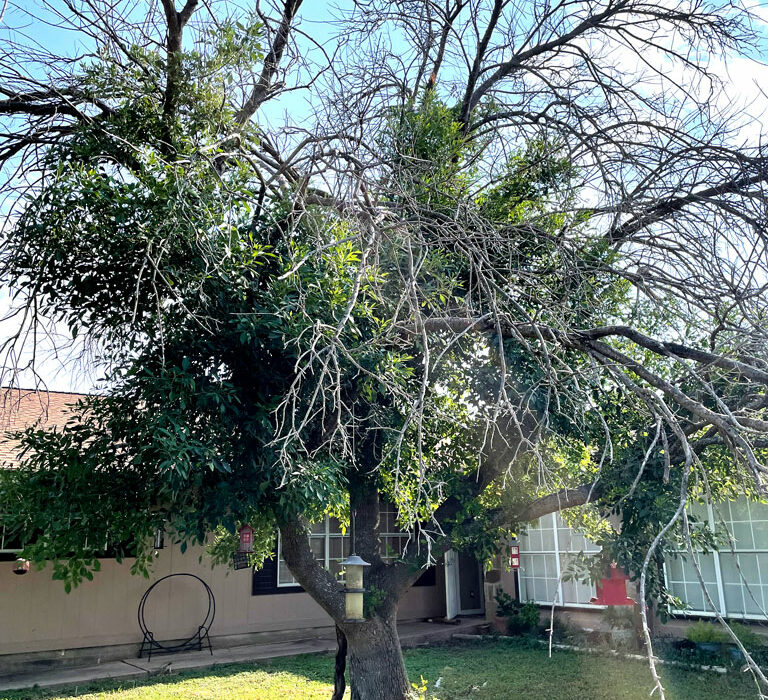
Remove dead branches from trees to get rid of the fuel load near your home and on your property. Photo by Martelle Luedecke
We’ve had some rain. Grass and shrubs grew. Now, the grass is high and dry. We stopped by to speak with Kelly Tarla at the Burnet County AgriLife Extension office to discuss the situation and gather resources. We asked: "What should we do?"
“The main objective is to get rid of the fuel load," Tarla said.
- Fuel load could determine if a fire is going to start and definitely determines the intensity of the fire.
- Remove the fuel load by mowing and removing thatch from the grass. (You could use a mower with a collection bag attached.)
Look at your landscape.
- Do you have deadwood? Example: Branches that didn’t recover from the freeze; shrubs that need pruning.
- Laddering landscape: “Fuel that can carry a fire burning in low-growing vegetation to taller vegetation is called ladder fuel.” (surviving-wildfire.extension.org)
- Examples of local plants that could be the base of a fuel ladder due to the extreme weather conditions that we have experienced in the last two years: Salvia greggii (autumn sage). Salvia tends to get leggy if it’s not trimmed. So, you might have some random dead wood. Older Texas sage is another example. Ash trees did not do well either during the freeze of 2021.
- Although the base of your ash trees may be recuperating, you might have dead limbs up high. Even though the ton of deadwood is high up, embers can still get up there — especially with the wind that we have had!
- Anything that is dead is going to be a fuel for fire! Therefore, remove as much thatch and deadwood as you can from around your home and on your property. Try to take it to a city or county dump. Remember: Do not put them on your neighbor’s property.
- If you’re out in a rural area with no irrigation, Kelly further suggests Firewise landscaping. Low-growing, moist plants (Columbine, violet, primrose, phlox) within 10 feet of your home. Taller plants such as bluebells, bluebonnets, aster, and gay feather could be used 10-30 feet out from your home. Then, 30 feet and beyond, shrubs such as Turks cap or butterfly bush.
- Tree height landscaping for distance (from your home) zones is also suggested. Lacy oak in zone 1 closer to your home, then further out Monterey oak due to the height of the trees. The idea is that there is NO underbrush by your house!
- Double check your mulch around the house. Even if it is flame retardant, how old or dry is it now? Around your house, keep a green belt and wood moist if possible.
- Try to thin your cedar trees. Again, if they are dead, “they’ve got to go. … Cedar has an oil in it, so it burns hotter than a lot of other stuff … and quickly. It’s almost like an explosive.”
- Resources for home landscaping checklists to teaching tools to instruction can be found at these links: www.firewise.org and www.tfsweb.tamu.edu.
- The National Fire Prevention Association has a free online training for Reducing Wildfire Risk for People and Property at www.nfpa.org.
Till next time. Keep your souls and soles in your garden!
Remember the True Master Gardener: Jesus said, “I am the vine; my Father is the Gardener.” John 15:1
"In the Garden" is written by father-daughter duo Bill and Martelle Luedecke and Bill Luedecke. Contact Martelle at 512-769-3179 or luedeckephotography@gmail.com. Contact Bill at 512-577-1463 or bill@texasland.net.













